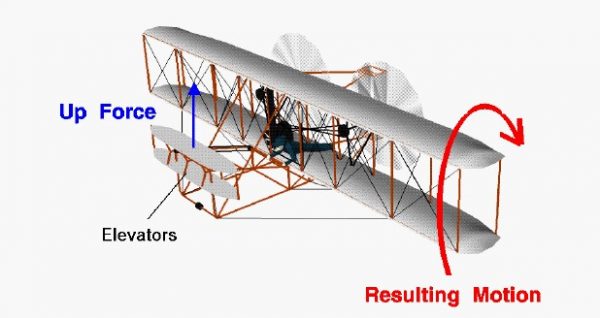Aircraft Elevator Interactive
At the front of all of the Wright brothers’ aircraft one finds the elevators. The elevators are a pair of movable wings which are controlled by the pilot. This slide shows what happens when the pilot deflects the elevators leading edges upward. How does changing the elevator angle affect the aircraft?

Let’s investigate how the elevator works by using a JavaScript simulator.
Lift
As described on the inclination effects page, changing the angle of attack of a wing or airfoil changes the amount of lift generated by the foil. With greater upward deflection of the leading edge, lift increases in the upward direction. With a downward deflection, lift increases in the downward direction. The lift force of the elevator is applied some distance from the aircraft center of gravity. This creates a torque on the aircraft and the aircraft rotates about its center of gravity. Pulling the leading edge upward will cause the entire aircraft to pitch nose up. The pilot can use this ability to make the airplane rise or dive.
Wing
The placement of the elevators at the front of aircraft is rather unique for the Wright flyer. Modern aircraft typically have the elevator at the rear, attached to the horizontal stabilizer. The Wright’s placed their elevator at the front to provide protection to the pilot in the event of a crash. (The pilot of this aircraft lies next to the engine on the lower wing.) But there is also a static performance advantage when the elevator is placed forward. Lifting wings have a natural tendency to flip tail over nose because of the way the pressure is distributed. To overcome this tendency, the horizontal stabilizer on modern aircraft are usually set at a negative angle generating a negative lift force to keep the tail down and the airplane trimmed. This negative force must be overcome with greater lift by the wings. But, with the elevator in the front, the normal angle is set slightly positive to trim the aircraft and this positive lift is added to the wing’s lift to get the airplane off the ground. For a power-limited aircraft like the Wright Flyer, this is a better arrangement than having the elevator at the rear.
Pitch
There is a disadvantage to this arrangement, however, which the Wright brothers worked for several years to overcome. If the airplane is displaced in pitch, by a gust of wind causing the nose to pitch up, the angle of attack on the elevator increases. This increases the lift force of the elevator, which causes the nose to pitch up even more. The aircraft can become quite unstable in pitch and hard to fly depending on the size of the elevator, the distance to the center of gravity, and the natural moment (tail over nose) of the wing geometry. The Wright 1903 and 1904 flyers had serious pitch problems created by the forward elevator. It wasn’t until the re-design of 1905 that the brothers solved this problem. The Wright flyers were highly maneuverable but not very stable. The brothers had to constantly provide the stability for the aircraft by working the flight controls to change the elevator setting. Like the Wright 1903, modern fighters are also designed to be highly maneuverable but not very stable. Fighters now use a computerized stability augmentation system (SAS) to reduce the work load on the pilot.
You can view a short movie of “Orville and Wilbur Wright” explaining how the elevator was used to control the pitch of their aircraft. The movie file can be saved to your computer and viewed as a Podcast on your podcast player.
